OSA educators offer in-person and digital community presentations; activity or exhibit-based information booths at events; OSA facility tours for small groups; and para-professional training for land stewards, environmental professionals, and volunteers. Whether you are scheduling for an open-to-the-public event or a private event for a special interest, we have selection of scholarly, informative lectures and activities adaptable to multiple audience types.
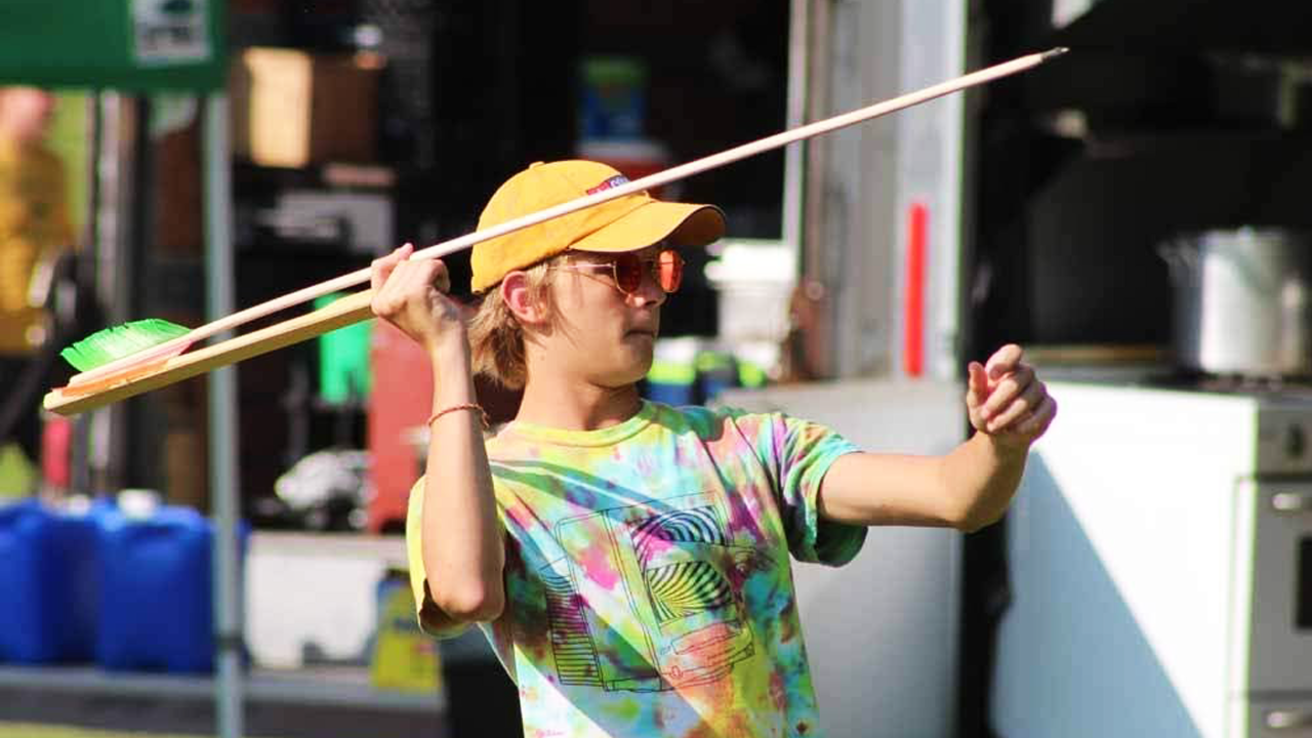
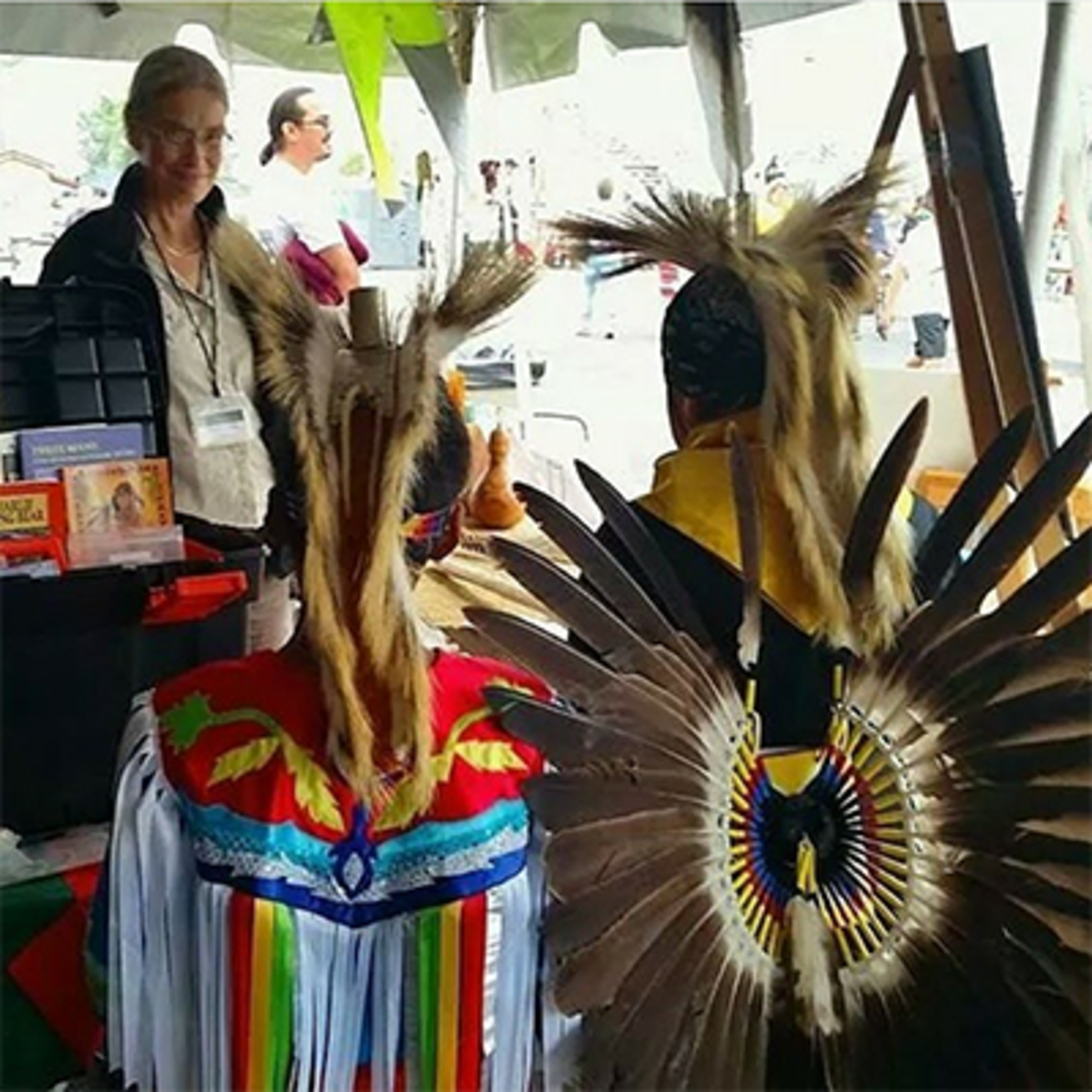
Unfortunately, our public activities are unfunded. It is appreciated when organizations or communities can contribute to the costs for OSA outreach services. Basic expenses include mileage/vehicle and an hourly rate for travel/presentation time. Costs increase with distance from Iowa City, but do not let that discourage an inquiry!
If you know someone willing to make a contribution to help us defray the costs of visiting communities across the state, please let them know they can support us with a tax-deductible, charitable donation!
Information & Exhibit Booths
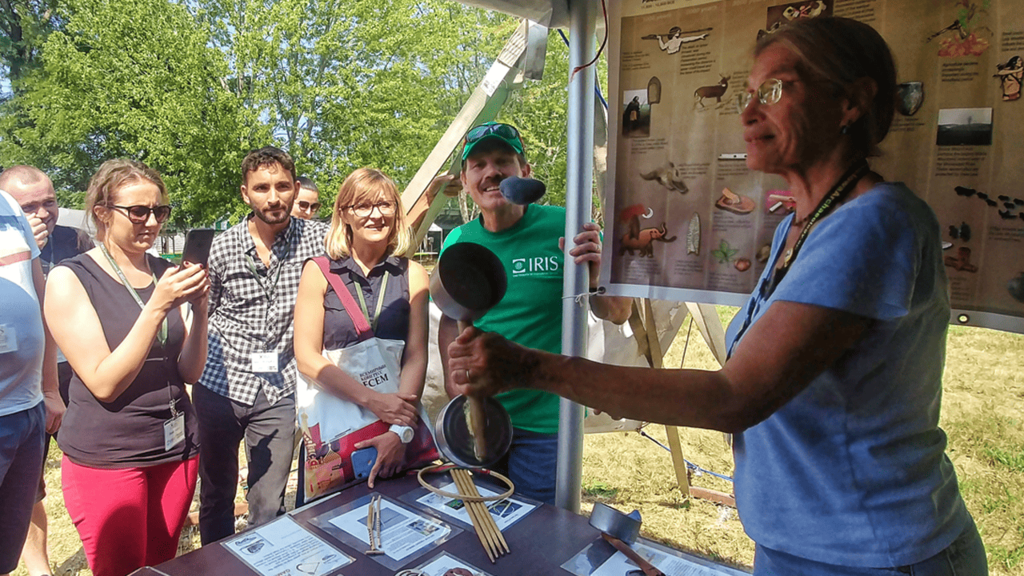
Informal Outreach
OSA archaeologists set up and staff information and exhibit booths and tables at community events, local celebrations, school science nights or STEM festivals, archaeology road shows, and more. For displays, we travel with a portable Iowa archaeology timeline of authentic artifacts, set up panels and posters, offer a selection of traditional games and activities, and more. You can find us set up at the Meskwaki Powwow every year!
For these events, we determine fees based on the number of staff needed, hours required for event and travel time, and vehicle costs. Let us know if you need an archaeologist with a particular research expertise to provide information or demonstrations to your visitors.
Office Tours for Small Groups
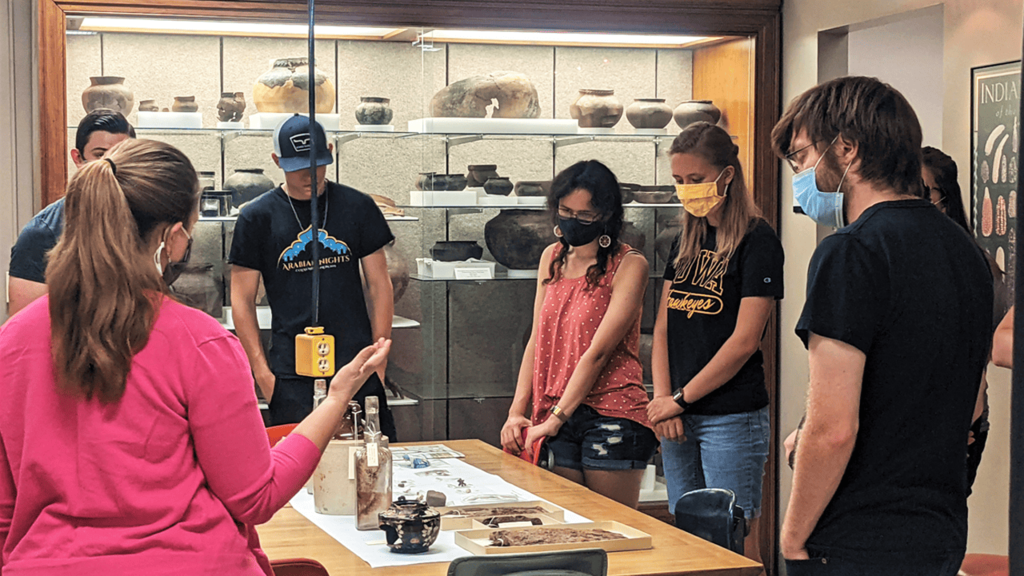
Visitors are welcome at the OSA!
We are happy to tour anyone who wishes to visit. We must emphasize that as a working archaeological research facility, we unfortunately have limited displays and educational resources for the public and groups. During a tour, visitors can expect to walk through our offices and labs, view some of our comparative collections, and look inside the repository. A walk-through tour takes about 45 minutes.
Normal hours are 8:00 a.m. to 4:30 p.m., Monday through Friday year-round. The OSA is closed on University holidays.
Guided Waterway Tours
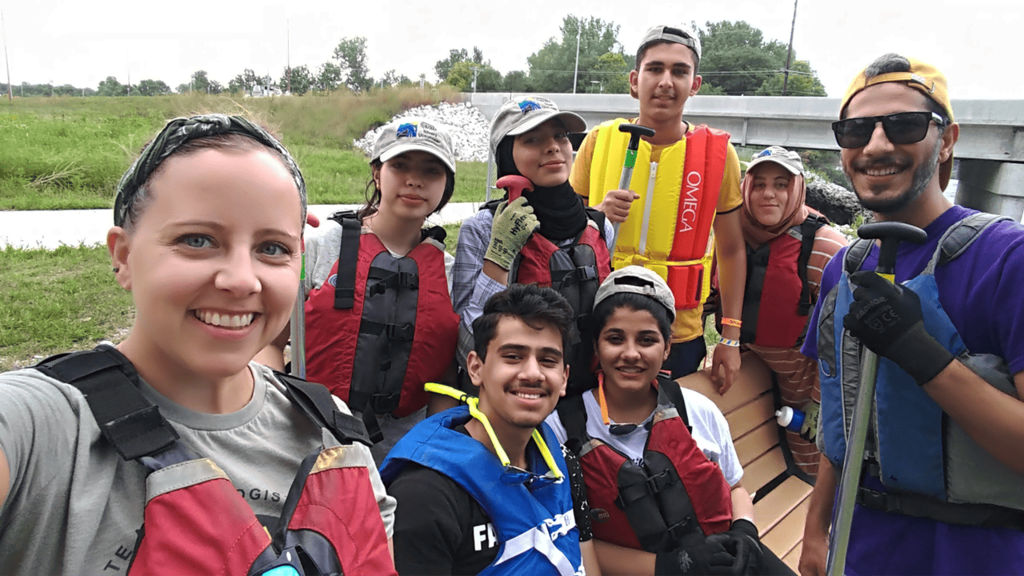
Public Archaeology along Iowa's Rivers
OSA archaeologists contract with the Iowa DNR, county conservation boards, and other organizations to give interpretive paddle trips on Iowa waterways. Let us know if you are interested in setting up a paddle trip! We also participate annually as resident archaeologists at Iowa Project AWARE.
For paddle trips, we determine fees based on the number of staff needed, hours required for event and travel time, and vehicle costs. Let us know if you need an archaeologist with a particular regional expertise to provide information to your participants.
Para-Professional Training
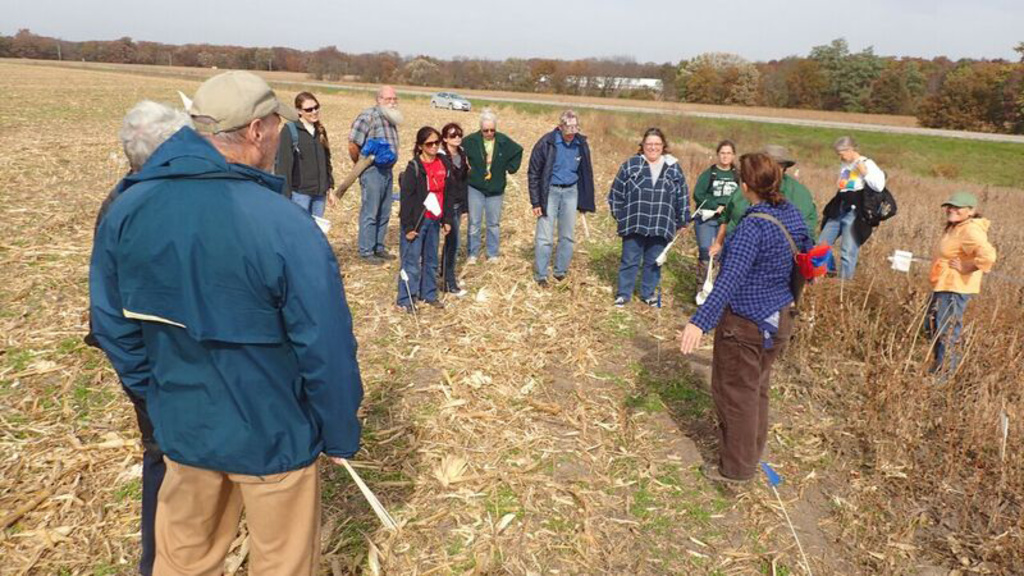
Stewardship Workshops
OSA offers half-day to one-day workshops for environmental professionals, naturalists, parks and public lands personnel, construction teams, and other groups that may encounter or manage archaeological resources during the course of their work. This workshop designed to familiarize participants with the basic identification of precontact and historic archaeological resources, including artifacts and common site types. Participants learn about laws affecting sites on public lands; how to proactively protect cultural sites; and best practices for creating for-the-public interpretive information about their sites. They receive hands-on practice with identifying common artifact types, filling out archaeological site forms, and submitting records to the state site file. Portions of this workshop can be done outdoors, depending on the location.
Costs for services will be determined by a contract that covers staff time, travel, and workshop materials.
Community Lectures
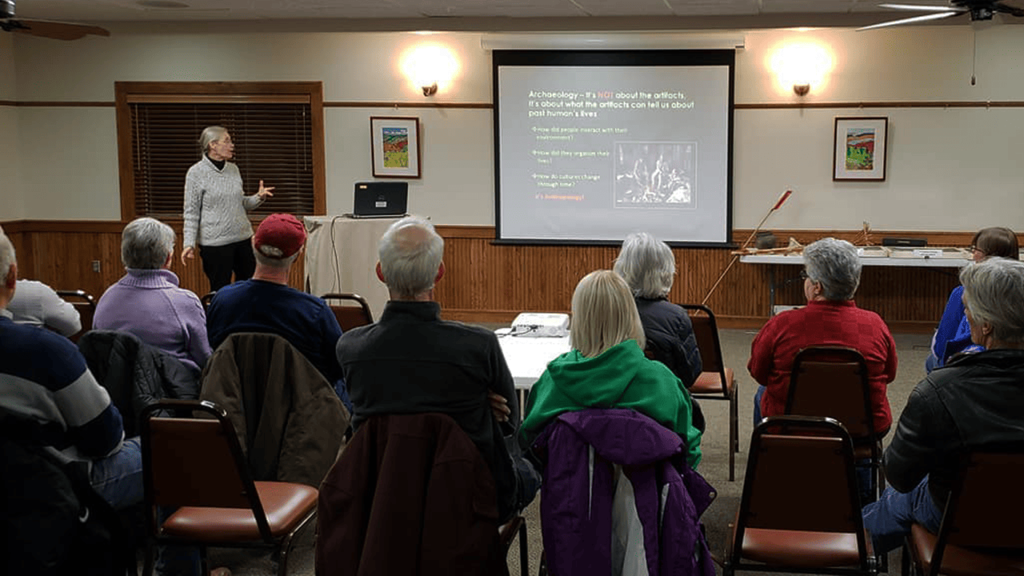
Scholarly, Interpretive Lectures
Our public program catalog includes one-hour lectures that are perfect for community programming at libraries, nature centers, local museums, retirement communities, special interest groups such as rotary clubs, and more. Choosing an option from our program menus below helps to keep our costs at a minimum. We are happy to customize programs or develop new ones for additional fees.
Community Program Menu
The 1837 Ioway Map
This map illustrates villages and travel routes of the Ioway people. Learn about why it was created and see archaeological objects from sites located on the map.
Ancient Technology in Iowa: How Did They Do That?
Ancient technology was incredibly innovative. Learn about flint knapping, pottery making, bone tools, unique uses for plants, and more.
At Home in Iowa: The Archaeology of Homes in the 19th and 14th Centuries
This program compares objects and features found during archaeological excavations from a 19th century dairy farmstead in eastern Iowa and a 14th century ancestral Native American earthlodge home in western Iowa.
Avocational Archaeologists: Collectors Helping Preserve Iowa’s Past
Iowans have been enthusiastic about artifact hunting for generations. When conscientious avocational archaeologists partner with professionals, we build our knowledge of the archaeological past in ways we couldn’t do alone. We focus on four collectors who have made important contributions to our understanding of Iowa archaeology.
Beyond Food: Ancestral Native American Use of Deer and Bison
Hunting was a vital resource for Ancestral Native Americans. Besides essential nutrition, bison and deer provided raw materials for everything from tools and string to musical instruments and beautiful artwork. Archaeology provide a glimpse into the creative uses found for these creatures.
Crops of Ancient Iowa
Archaeological evidence for Iowa's first domesticated plants stretches back about 4000 years. What were people growing and where? Some of their staple crops might surprise you! This program can be accompanied by a display of a sample of real and replica artifacts from relevant time periods.
Cycles of the Seasons: Meskwaki Then and Now
Meskwaki trace their origins far to the east in present-day Quebec. Over the centuries they moved westward and entered the Iowa/Illinois region in the 17th century. Based on archaeological research, ethnographic studies, and research by Meskwaki historians this program presents what we know about the Meskwaki traditional lifestyle and the Meskwaki in Iowa today.
Note: When possible, we encourage you to seek out speakers and first-hand resources from Iowa's descendant tribal communities. The information we present has been developed over the years based on archaeological information and communications with our tribal partners. We are grateful for their partnership!
First Nations: Those Who have Gone Before
A look at the indigenous cultures of Iowa with a special focus on the Ioway and Meskwaki and their contributions to our understanding of Iowa's past.
Note: When possible, we encourage you to seek out speakers and first-hand resources from Iowa's descendant tribal communities. The information we present has been developed over the years based on archaeological information and communications with our tribal partners. We are grateful for their partnership!
From Garbage to Culture: How Do We Know?
Archaeologists learn about past lifeways from what was lost, tossed, and left behind. Follow an archaeological excavation from the recovery of artifacts to final understanding of what those artifacts mean about the people and cultures associated with them. This program can be accompanied by a display of a sample of real and replica artifacts from relevant time periods.
Ice Age Iowa
People began moving into Iowa over 13,000 years ago at the end of the last “ice age”. This was a time of giant land mammals, ice, and extreme cold temperatures. Learn about what Iowa was like during this period and how people adapted to the conditions. This program can be accompanied by a display of a sample of real and replica artifacts from relevant time periods.
I Know What They Ate
From analyzing plant and animal remains to isotope analysis of teeth and bones and detailed study of ethnographic accounts, archaeologists have a variety of techniques for learning about food ways of people of the past. Learn about some of these approaches and what we currently understand about what people were eating in the ancient past.
The Impacts of Fakes, Forgeries, and Natural Objects on Building Archaeological Knowledge
In archaeology, what defines an artifact? How do we tell when something is natural versus human-made or authentic versus a forgery? When it comes to personal collections, does it matter? We explore how archaeologists define artifacts, laws and ethics that strive to guide the the hobby of artifact hunting, and how forgeries and the buying and selling of artifacts impact our study of the past.
An Iowa Archaeology Road Trip
Explore the range and diversity of artifacts types in Iowa, from deep time to recent history, and learn about the people these objects tell a story about.
The Meskwaki Talking Papers
Around 1830, Wacochaci, a important Meskwaki chief, created amazing pictographs on pen and paper that depict 100+ species of animals, birds and fish. View these pictographs and see archaeological artifacts that were created from or relate to species drawn by Wacochachi.
Native American Uses for Plants
Learn about objects in the OSA collections that illustrate the many non-food uses that Native People of North America found for plants. Plants from trees to grasses were utilized for building and wood carving, weaving and sewing, and creating colorful and beautiful objects.
Pets and Domestic Animals: Making Themselves Useful
Archaeologists usually find animal bones that signify food resources or invaders of food stores, but sometimes we find evidence that tells us about special relationships between humans and animals. Domestic animals were companions, assisted with labor, and may have played symbolic roles in the spiritual and cultural lives of the site inhabitants. Here we examine artifacts at OSA that teach us about humans and their animals in Iowa’s past.
Style and Adornment from the Past – What Are People Saying?
When people choose what clothing and adornments to wear, they send messages to those around them. For those “in the know” these choices can reflect cultural rank or status, particular skills, or spiritual relationships. This program takes a deep dive into OSA collections to examine artifacts associated with personal adornment, from 18th-20th century Euro-American and Native American sites and from ancestral Native American sites dating back 1000+ years. Can we understand what people of the past were communicating?
Traditional Native American Toys and Games
The majority of the artifacts recovered in archaeological excavations tell us about what people ate and how they obtained it. Some less common artifacts, however, are clues to the other dimensions of people’s lives, such as entertainment. We know that men, women, and children have always enjoyed the challenge and fun of playing games. Learn about some traditional toys and games, and even try some out.
A Walk Back Through Time
Iowa has a unique archaeological past! This presentation provides a general overview of the last 13,000 years of Iowa's past as known through archaeological study. This program can be accompanied by a display of a sample of real and replica artifacts from relevant time periods.
Where Did They Live? Building Earthlodges and Wickiups
Everyone needs shelter. In Iowa, the most common traditional shelters were either large earthlodge structures or mat-covered wickiups. This program takes a look at both archaeological and ethnographic information to discuss these house types and how they were constructed. This program can be divided to focus on one or the other traditional structures.
The Woodland Period: Diversification and Expanding Contact
Learn about the Woodland archaeological time period, about 2,500 to 1,000 years ago, when agriculture, mound building, and wide-spread trade networks took off. This program can be accompanied by a display of a sample of real and replica artifacts from relevant time periods.